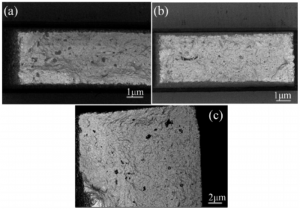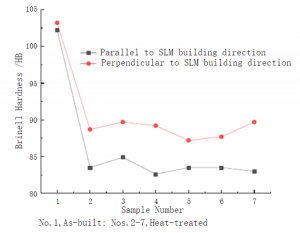Using Two-Stage T6 Heat Treatment to Tailor the Mechanical Properties of 3D Printed Aluminum AlSi10Mg Alloys

Backscattered electrons images to observe oxidation regions of (a) T6 heat-treated, and not in (b) as-built, selective laser melting samples, (c) magnification of (a).
While many aluminum alloy components are still fabricated using traditional casting technologies, there’s been plenty of research and development into 3D printed aluminum alloys as well. For metallic 3D printing, the selective laser melting (SLM) method is typically used to produce Al alloys; however, AlSi10Mg alloys made with SLM technology must set up different post-printing treatments. This is due to a rapid cooling rate during the solidification process, which causes the microstructure and mechanical properties of the part to be vastly different from conventional cast or forged metal alloys.
Additionally, high heat transfer, high reflectivity to the laser beam, and easy oxidation to a tenacious oxide film make SLM-produced AI alloys more difficult than those of steel or titanium.
A pair of researchers recently published a paper, titled “T6 heat-treated AISi10Mg alloys additive-manufactured by selective laser melting,” in the Procedia Manufacturing journal about tailoring the mechanical properties of SLM-fabricated AlSi10Mg alloys with a two-stage T6 heat treatment.
The abstract reads, “A two-stage T6 heat treatment has been proposed to tailor mechanical properties of the selective laser melting fabricated AlSi10Mg alloy. The process included solid solution at 535 ºC and artificial aging at 158 ºC for 10 h. The densification, hardness and oxidation behavior have been investigated after T6 heat treatment. The results demonstrate that the hardness of the T6 heat-treated samples are lower than untreated ones. This is because a fine-grained recrystallization microstructure develops during solid solution. Oxides aggregation and dimple distribution occurred due to sufficient diffusion at the artificial aging of the second stage.”

Optical microscopy images of (a) as-built selective laser melting, and (b) magnification; (c) T6 heat-treated, and (d) magnification, samples perpendicular to building direction of selective laser melting.
The T6 heat treatment is most often used to increase the strength of Al-Si components with Cu and/or Mg in conventional manufacturing, which uses a high-temperature solution treatment to both dissolve larger intermetallic particles and homogenize the alloying elements. Then, lower temperature artificial aging is used to form fine precipitates.
New studies show that T6 heat treatment can actually cause cast alloys to soften, instead of harden, when they’re annealed at either 300 ºC or 530 ºC, which contrasts earlier research. In addition, SLM-fabricated AlSi12 post-solution had a 25% increase of ductility.
“However, most research so far focuses on how to increase the tensile strength during selective laser melting processing, only a few can refer to balancing plasticity and the resistance to facture by post heat treatment. Furthermore, only limited comprehensive work has currently been done to study heat treatment processes specific for selective laser melting-fabricated AlSi10Mg alloys, particularly on their influence on the mechanical properties,” the researchers wrote. “Thus, this raises the need to verify conventional T6 heat treatments when it comes to selective laser melting materials, and what would be the influence of these heat treatments on the specific mechanical properties of selective laser melting-produced AlSi10Mg alloys.”
The paper’s proposed thermal treatment uses a solid solution at 535 ºC and artificial aging at 158 ºC for 10 hours on gas-atomized AlSi10Mg powder provided by Renishaw. Then, the researchers investigated the impact of their two-stage T6 heat treatment on both the mechanical and microstructural properties developed in SLM 3D printed samples.
The samples’ mechanical properties depend on the densification mechanism of the parts, and their microstructure during SLM processing.
“In AlSi10Mg alloys, the theoretical bulk density usually is 2.68 g/cm3. After the selective laser melting processing, the densification of the as-built samples was 96%. By contrast, after T6 heat treatment, the mean value of the densification of the samples is 96.52% and the maximum densification is 98.13%,” the researchers wrote.
These similar values are an indication that the two-stage T6 heat treatment had very little effect on the SLM 3D printed parts’ densification. Additionally, post-T6 heat treatment, the hardness of the as-fabricated sample in a building direction significantly decreased as well. Evidence also shows that the T6 heat treatment can spheroidize oxidation regions to even further enhance the mechanical properties of SLM 3D printed samples.
The researchers concluded, “This heat treatment aims to tune the mechanical behavior of selective laser melting-produced AlSi10Mg alloys. The effects of the T6-like heat treatment on the densification, hardness, and oxidation behavior have been investigated. Similar densification of 96% in the as-built samples and of 96.52% in the heattreated samples indicates that the T6 heat treatment has no importance to the densification. Decrease by about 20% in the hardness of heat-treated samples compared with the selective laser melting as-built samples. The T6 heat treatment can spheroidize oxidation regions and thereby form dimple structure. This finding can offer an intriguing insight into explore oxidation behavior and mechanical properties of selective laser melting-fabricated AlSi10Mg alloy using a two-stage heat treatment.”
Co-authors of the paper are Xianglong Yu with the CAS Key Laboratory of Mechanical Behavior and Design of Materials (LMBD) at the University of Science and Technology of China and Lianfeng Wang with Shanghai Aerospace Equipment Manufacturer.
Discuss this and other 3D printing topics at 3DPrintBoard.com or share your thoughts below.
Subscribe to Our Email Newsletter
Stay up-to-date on all the latest news from the 3D printing industry and receive information and offers from third party vendors.
You May Also Like
3D Printing Unpeeled: New Arkema Material for HP, Saddle and Macro MEMS
A new Arkema material for MJF is said to reduce costs per part by up to 25% and have an 85% reusability ratio. HP 3D HR PA 12 S has been...
3D Printing News Briefs, January 20, 2024: FDM, LPBF, Underwater 3D Printer, Racing, & More
We’re starting off with a process certification in today’s 3D Printing News Briefs, and then moving on to research about solute trapping, laser powder bed fusion, and then moving on...
3D Printing Webinar and Event Roundup: December 3, 2023
We’ve got plenty of events and webinars coming up for you this week! Quickparts is having a Manufacturing Roadshow, America Makes is holding a Member Town Hall, Stratafest makes two...
Intuitive Machines Debuts $40M Hub for Lunar Ambitions and 3D Printing Tech
Best known for its pioneering work in lunar exploration and its development of the Nova-C lunar lander, Intuitive Machines (Nasdaq: LUNR) has marked yet another significant milestone. The leading space...
































